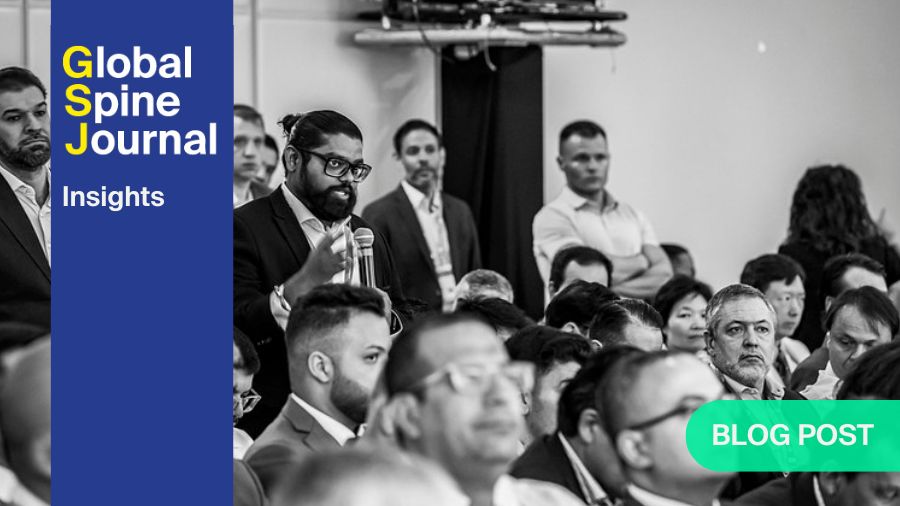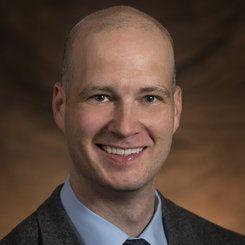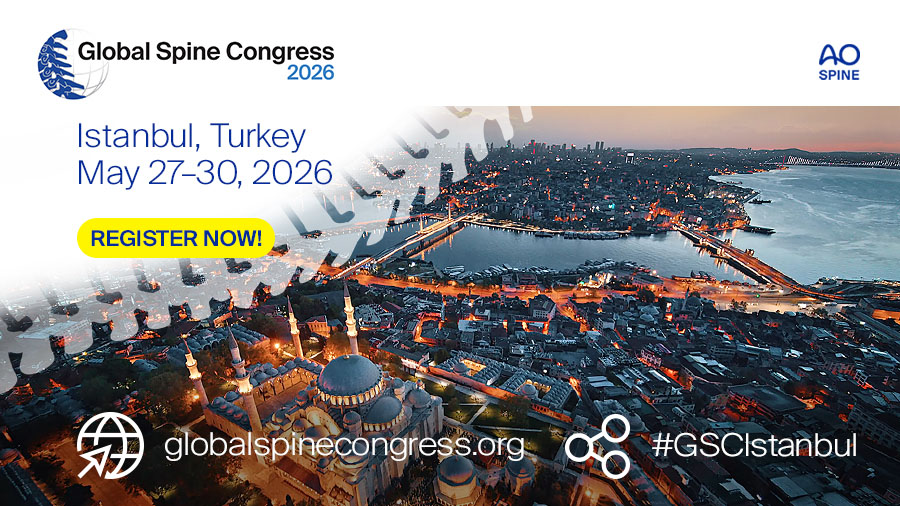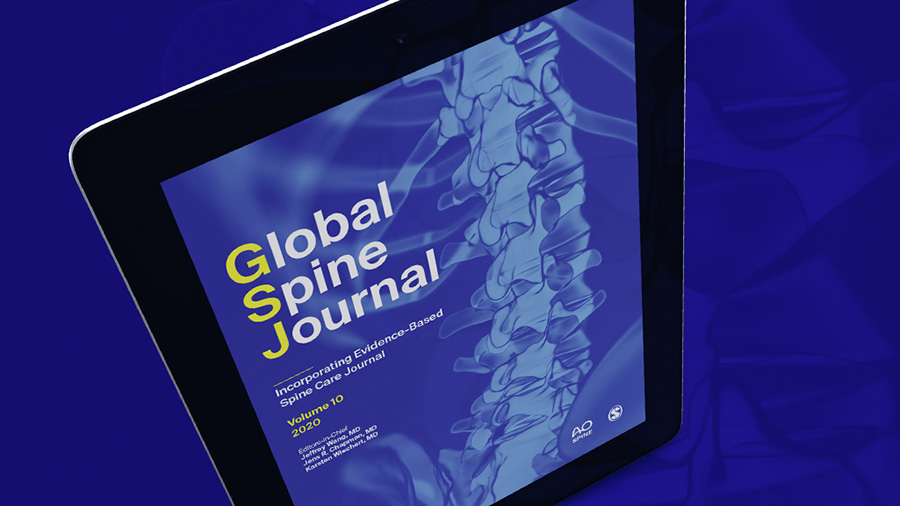Bridging borders in spine surgery: how the Global Spine Congress is setting a new standard for international representation
BY DR JONATHAN DALTON AND DR GREGORY SCHROEDER

Spine disorders know no borders, yet the platforms where surgical expertise, innovation, and education are exchanged often fall short of global representation. The conclusions from a recent study published in the Global Spine Journal analyzing the geographic and economic diversity of participants at major international spine conferences are revealing: the majority of invited speakers and committee members hail from a select few high-income countries. However, the Global Spine Congress (GSC), the flagship meeting of AO Spine, stands out as an important exception—and a model worth looking at in more detail.
-
Read the quick summary:
- The study analyzes geographic representation at leading spine conferences.
- While almost 90% of speakers at major conferences are from high-income nations, GSC stands out with nearly 70% of speakers from diverse global regions.
- This study advocates greater inclusion, to submit abstracts to GSC, and fostering more global collaboration in spine care.
- Suggested steps to promote inclusion: leadership diversity, funding to support access, and virtual and hybrid options. Future research should explore effective inclusion strategies.
Disclaimer: The article represents the opinion of individual authors exclusively and not necessarily the opinion of AO or its clinical specialties.
Dalton J, Baidya J, Huang R, et al. Characterizing the Representation of Different Global Regions and National Income-Levels Amongst Invited Speakers and Committee Members at Major International Spine Surgery Conferences. Global Spine Journal. 2025;0(0).
The burden is global, but local voices should be amplified
Spinal conditions contribute significantly to global disability, with an especially heavy burden in low- and lower-middle-income countries. These regions face higher rates of spinal trauma, infections such as tuberculosis, and limited access to surgical care. Despite this, surgeons from these regions are frequently underrepresented at major spine surgery conferences. Although this finding is certainly not due to intentional exclusion on the part of spine conference leadership, it nevertheless represents an opportunity for greater idea exchange and synergy between spine surgeons from disparate global regions.
In analyzing six of the largest international spine conferences—Eurospine, GSC, IMAST, ISASS, NASS, and SRS—the study reviewed speaker lists and committee memberships from 2022 to 2024. Amongst invited speakers, 89.7% came from high-income countries, with no representation from low-income countries. Nearly 60% of all speakers hailed from the United States and Germany.
Global Spine Congress: a model of inclusion
Among all conferences analyzed, the GSC emerged as the most internationally inclusive. Approximately 69% of its invited speakers were from regions different from its executive board, compared to just 11% at ISASS and 13% at NASS. GSC also led in economic diversity: 9.7% of its speakers came from lower-middle-income countries, and 25.5% from upper-middle-income nations.
GSC’s approach reflects the ethos and mission of the AO Foundation and AO Spine—an organization committed to advancing spine care globally through education, research, and shared clinical expertise. By intentionally inviting speakers from underrepresented regions, GSC creates a forum where diverse perspectives enrich the conversation, leading to more applicable and sustainable solutions for a wider range of spine conditions and patient populations.
Why representation matters
Including more surgeons from low- and middle-income countries is an important source of enrichment for international discussions. Surgeons working in resource-constrained environments often innovate out of necessity, finding cost-effective ways to manage complex cases.
These insights are invaluable, which is further demonstrated by Dr S Rajasekaran’s AO Spine Guest Article on Why developing countries must do their own innovations and research.
Moreover, additional visibility at international forums can promote career growth, collaboration, and research development for surgeons in underserved regions. Conferences offer networking, publication, and partnership opportunities. Thus, fostering participation from diverse nations can improve equity and access to these professional milestones.
What limits global participation and how conference organizers can drive change
Several barriers restrict broader global participation in scientific congresses. We identified key barriers that could be addressed by practical measures:
- Cost: Registration fees, travel, and lodging costs can be challenging for surgeons from low- and middle-income countries.
- Language and accessibility: Presenting at and attending conferences often require proficiency in English, as well as comfort with academic presentation formats.
- Lack of infrastructure: In some regions, limited access to the internet, educational resources, or institutional support can hinder submission and participation.
Virtual and hybrid conference models, used extensively during the COVID-19 pandemic, provide a scalable solution to these challenges. They reduce costs and can leverage real-time translation tools—implementation of these strategies can foster more active engagement from conference attendees and greater idea-exchange between invited speakers.
To drive diversity and inclusion, the following tactics could be employed to address the key barriers mentioned above:
- Diversify selection committees: Conference executive boards may include members from varied geographic and economic backgrounds. Improved representation in leadership positions can influence speaker invitations.
- Offer subsidies and waivers: Provide travel grants, registration discounts, or full waivers for surgeons from lower-income countries. Partnerships with industry or philanthropic organizations can help fund these programs.
- Prioritize international abstracts: Actively encourage abstract submissions from underrepresented regions. Offering mentoring or editorial support can help ensure these submissions meet publication standards.
- Include virtual speaking opportunities: Remote presentations can lower costs and logistical barriers for invited experts.
- Report diversity metrics: Like this recent study, conferences may consider publishing annual reports on regional and economic diversity to track progress and improve transparency.
The power of inclusion—a call to spine surgeons
International meetings are major opportunities for underrepresented countries to join global discourse on important research and clinical topics in spine surgery. The GSC has demonstrated that intentional design is important for improvement of inclusivity. By broadening access, major governing academic bodies and international conferences can improve the degree to which spine surgery is globally representative. In these ways, GSC can serve as a blueprint for other spine conferences and organizations that aim to make a lasting global impact.
It is incumbent upon spine surgeons who participate in or submit to the GSC to recognize that you are part of a pioneering effort to democratize spine surgery on a global scale. To this end, we encourage advocacy within your network’s submission of research, support for your colleagues from other regions, and volunteering for international collaborations.
If you're affiliated with another conference, consider some of the goals and strategies laid out by GSC that may serve as a benchmark for global inclusivity. Global leadership in spine care means facilitating involvement from all regions, including those bearing the highest burdens and facing the steepest challenges.
About the authors:
Dalton is a member of AO Spine and has particular research interest in outcomes following spine trauma and infections.
Schroeder is the chairperson on AO Spine Knowledge Forum Trauma and Infection. He has authored hundreds of peer-reviewed publications, has edited numerous textbook chapters, and has presented both nationally and internationally on spine surgery research and techniques. He has chaired multiple international spine surgery meetings including the Cervical Spine Research Society, and the North American Spine Society’s summer meeting. He holds several editorial positions, including Editor-in-Chief for Clinical Spine Surgery in Philadelphia, PA. He has conducted extensive research in the field of spine surgery and continues to actively do so.
References and further reading:
- Dalton J, Baidya J, Huang R, et al. Characterizing the Representation of Different Global Regions and National Income-Levels Amongst Invited Speakers and Committee Members at Major International Spine Surgery Conferences. Global Spine Journal. 2025;0(0).
You might also be interested in:
Global Spine Congress
GSC is one of the world's largest spine meetings bringing together spine surgeons from around the world for a unique experience, the latest knowledge, innovations, and technologies.
Global Spine Journal
AO Spine’s official scientific journal is an open access, peer-reviewed journal focusing on the study and treatment of spinal disorders. AO Spine members benefit from an exclusive APC waiver.
AO Spine Knowledge Forums (KF)
The KFs are the engines of AO Spine clinical research. They perform evidence-based research and develop AO Spine classifications, staging of the disease, treatment guidelines, and outcome measures.
AO Spine memberships
Becoming an AO Spine member is just the beginning! Join the leading global academic community in spine care and benefit from exclusive member privileges find out how we can support you in developing your career.









